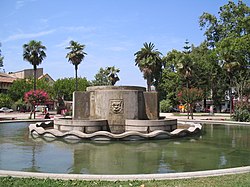This article needs additional citations for verification. (July 2022) |
Quillota | |
|---|---|
 | |
| Motto(s): City created with care (Ciudad creada con cariño) | |
| Coordinates: 32°52′S 71°15′W / 32.867°S 71.250°W | |
| Country | Chile |
| Region | Valparaíso |
| Province | Quillota |
| Founded | November 11, 1717 |
| Government | |
| • Type | Municipality |
| • Mayor | Óscar Calderón Sánchez (Independent) |
| Area | |
| • Total | 302 km2 (117 sq mi) |
| As of 2002 | |
| Elevation | 462 m (1,516 ft) |
| Population (2012 Census)[2] | |
| • Total | 85,262 |
| • Density | 280/km2 (730/sq mi) |
| • Urban | 66,025 |
| • Rural | 9,891 |
| Demonym | Quillotan |
| Sex | |
| • Men | 37,191 |
| • Women | 38,725 |
| Time zone | UTC-4 (CLT[3]) |
| • Summer (DST) | UTC-3 (CLST[4]) |
| Postal code | 2260000 |
| Area code | 56 + 33 |
| Climate | Csb |
| Website | Official website (in Spanish) |
Quillota is a city located in the valley of the Aconcagua River in Valparaíso Region, Chile. It is the capital and largest city of Quillota Province. It is surrounded by the localities of San Isidro, La Palma, Pocochay, and San Pedro. It is an important agricultural center, mainly because of the plantations of avocado and cherimoya trees.
Quillota is connected to the city of La Calera by the small city of La Cruz. Charles Darwin described the area's agriculture and the landscape in his book The Voyage of the Beagle. In nearby La Campana National Park, there is a plaque at a viewpoint commemorating Darwin's visit.
- ^ "Municipality of Quillota" (in Spanish). Retrieved 29 July 2010.
- ^ a b c "National Statistics Institute" (in Spanish). Retrieved 30 July 2010.
- ^ "Chile Time". WorldTimeZones.org. Archived from the original on 11 September 2007. Retrieved 29 July 2010.
- ^ "Chile Summer Time". WorldTimeZones.org. Archived from the original on 11 September 2007. Retrieved 29 July 2010.


